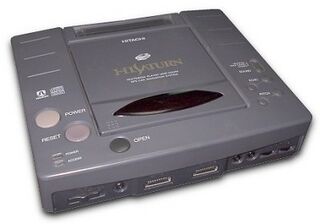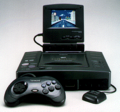Game & Car Navi HiSaturn
From Sega Retro

| ||||||||||
| Game & Car Navi HiSaturn | ||||||||||
|---|---|---|---|---|---|---|---|---|---|---|
| Manufacturer: Hitachi | ||||||||||
|
This short article is in need of work. You can help Sega Retro by adding to it.
The Game & Car Navi HiSaturn (ゲーム&カーナビ ハイサターン) (also known under a variety of condensed names, including HiSaturn Navi and Game Navi HiSaturn) is an unusual variant of the Sega Saturn, manufactured by Hitachi. Though Hitachi produced "HiSaturn" branded Saturns in Japan both before and after the HiSaturn Navi's release, this particular model is unlike any other version of the console - it is a "semi-portable" console designed to be used within cars and similar motorised vehicles.
The HiSaturn Navi is a fully functional Saturn console, but rather than drawing power from a traditional AC adaptor, it draws power from a car's cigarette lighter. In addition to the standard ports of a Sega Saturn (bar the traditional power supply), the HiSaturn Navi contains two microphone ports for karaoke, a port for a GPS antenna and a TV tuner port. Many of these components have since been incorporated into family cars without the need for extra purchases, though at the time of release, the HiSaturn Navi could have been considered quite innovative.
It is a slightly slimmer and smaller device than other Saturn consoles, but is a heavier unit due to added components unique to this console. A separate, foldable LCD screen was available for the HiSaturn which plugs into the rear of the unit - such devices would appear internationally for later PlayStation models and the Nintendo GameCube. The LCD screen was considered to be of reasonable quality for the time - the process of creating this method of television was still relatively new and expensive.
The HiSaturn Navi is an exceptionally rare edition of the console. At the time of release it was sold with the asking price of ¥150,000 (over three times the price of an ordinary Saturn), with an extra ¥45,000 required for the screen. The system was only in production for about a month, and only about 2,000 units were shipped in total (and only half as many screens). Second hand copies have been sold at auction for double, if not triple the original price.
Gallery
Promotional material
Physical scans



